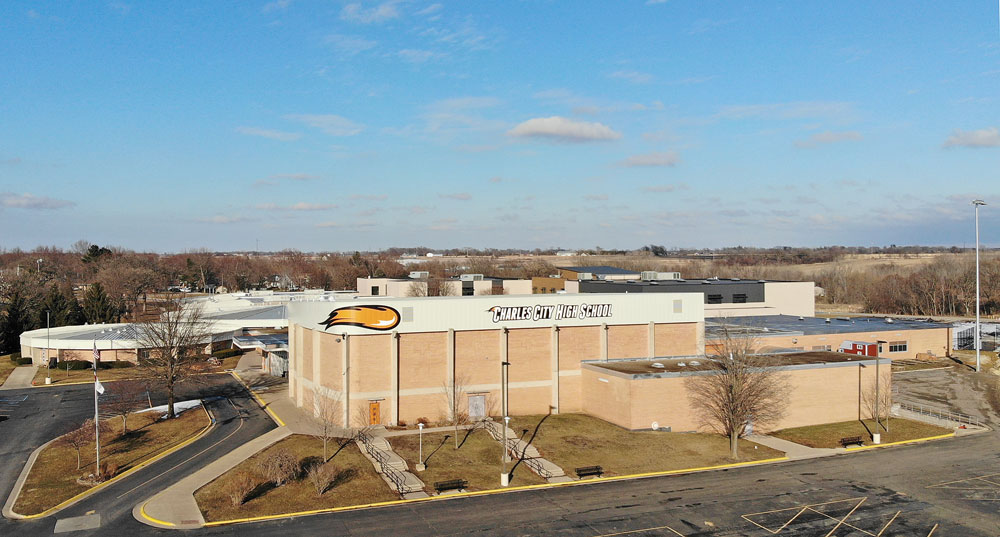Charles City Council weighs options on Fire Department future

By Travis Fischer, tkfischer@charlescitypress.com
The Charles City Council discussed the future of the city’s Fire Department during its workshop meeting on Wednesday.
With the impending departure of Fire Chief Eric Whipple and the state-wide difficulty in finding and retaining qualified volunteers, the city is considering its options for providing firefighting coverage to the community.
The council is in agreement that a full-time fire chief is needed at the very least. The greater issue is how many other full-time firefighters the city both needs and can sustain.
The idea of keeping a fire chief and otherwise relying on volunteers was discussed, but brought up concerns about both the availability of qualified volunteers and the impact such a system would have on area response time.
The city consulted with Whipple and his interim replacement, Marty Parcher, about their thoughts on what the city needs regarding volunteers and full-time employees.
Whipple said the average response time when the department had four full-time professional firefighters was about three and a half minutes. With periods now when there is no one at the fire station, that response time increases to eight to 10 minutes.
“Five is the magic number if you want to have one person staffed at the fire station 24/7,” said Whipple.
Council member Patrick Lumley was steadfast against relying exclusively on volunteers, stressing the importance of making sure residents and businesses can receive fast response times in case of a fire.
“If we think that volunteerism is going to solve this, we’re going down the wrong path and I will not be behind that at all,” said Lumley.
At the same time, full-time firefighters come with challenges of their own. The city will have to offer competitive pay to both attract and retain professional firefighters without losing them to neighboring areas.
“We don’t want to hire somebody and six months later have them going over to Mason City,” said Lumley, who asked to see models about how different numbers of full-time firefighters would impact the budget. “We want to retain people. We want them to stay in the community.”
Budgeting for a fully staffed Fire Department will be a challenge for the city and will possibly result in either cuts in other services, a rise in taxes, or a combination of the two, city officials have said.
“We’re cutting just about close to the bone as it is,” said council member Phillip Knighten. “There’s no easy fix for this.”
In other business, the council continued to discuss North Iowa Area Community College’s request to acquire a portion of the city-owned parking lot around NIACC’S downtown building near Hy-Vee, to use for the development of a high school career academy.
The academy had originally been proposed to be built on land at the fairgrounds, but that idea fell out of favor when rising costs inflated the price for new construction and the idea of remodeling and expanding the existing NIACC building was developed.
NIACC previously approached the city with a plan to build an 11,375-square-foot addition to its existing building, and the community college asked that the city effectively donate the land, selling a portion of the parking lot property for $1.
During the workshop, City Administrator Steve Diers addressed some of the questions the council brought up after the initial proposal was presented, such as how the development would impact parking in the area.
Diers said that the new building would eliminate 23 existing parking spaces in the NIACC corner of the lot, though five new spaces would be introduced in their place.
Usually the only time those parking spaces are used is on weekends during services in the churches across the street. Considering the times that the career academy would be in use, Diers said that the reduction in spaces shouldn’t make much of a difference.
“More often than not those stalls are open,” said Diers. “Generally speaking, we didn’t think that would be an issue.”
The preliminary plan for the addition also does not extend all the way to the southeast corner of the property, so the existing Eagle Scout landscaping project that sits on the corner would be left intact.
“I think this is a good win for the citizens of the city, bringing this into town,” said Lumley.
“I think this is a great fit for that spot,” said council member Keith Starr.
The council will expect to look at an official agreement at its Nov. 7 meeting.
In other development matters, Josh Mack appeared before the council to discuss an application for Façade Grant funds to support the construction of apartments on two Main Street properties. Mack is planning to renovate the upper floors of 217 and 219 North Main into apartments.
Mack is still in the process of purchasing the properties and getting estimates for construction, he said, but presuming all other qualifications are met, each property would be eligible for its own matching grant of up to $10,000 each.
Moving on, the council was presented with the newly completed Unified Development Ordinance. The Planning and Zoning Commission has spent the last two and a half years updating the city’s zoning and subdivision ordinances into a single new ordinance. The new ordinance combines some zoning categories, creates others, and generally brings the city’s zoning map up-to-date on modern subjects like signage and solar power.
Some of the new additions to the zoning map include the creation of flex districts, which allow for light industrial use and serve as a barrier between heavy industry and residential areas, and residential office transitional district that would allow some residential properties along North Grand Ave. to be used as office buildings without a residential requirement.
The council will hold multiple public readings of the ordinance before approval, giving the council members time to read the new ordinance in depth for themselves.
The council also discussed a request from Cambrex Inc. to receive a series of local incentives for a planned expansion. Cambrex is planning a $6.13 million administrative renovation which is projected to add 39 new jobs at an average wage of more than $30 per hour. That would qualify them for two forgivable loans amounting to $48,750 from the city and $22,500 from the Charles City Area Development Corp., along with a six-year property tax rebate on the added value of approximately $400,000.
Finally, the council received a preliminary construction plan for the Edible Arboretum Project. The new construction is intended to make the arboretum more accessible to residents by creating pathways while also serving as demonstrations for people to see firsthand how water quality improvements can be implemented on their own properties.
The project will be partially funded by a $100,000 grant from the sponsored project funds, which are reimbursed to the city through the state, though the city expects to spend about $20,000 on aspects of the project that can’t use sponsored project funds, such as sidewalk replacement.
Preliminary bidding plans are expected to be approved a public hearing date set at the Nov. 7 meeting.









Social Share